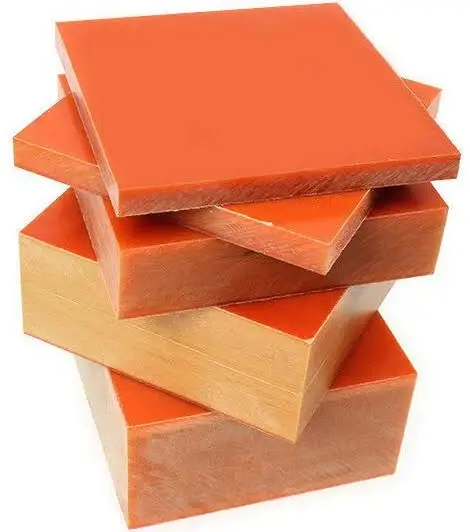What Are the Differences in Composition and Structure?
Raw Materials and Manufacturing Process
Phenolic paper sheets and phenolic cotton cloth sheets differ notably in their foundational materials and fabrication techniques. Phenolic paper laminates are created using layers of paper impregnated with phenolic resin, whereas cotton cloth laminates incorporate woven cotton fabric as the reinforcing element. The production process involves stacking multiple resin-impregnated layers, then applying heat and pressure, which cures the resin and fuses the layers into a solid composite material.
Density and Porosity Characteristics
Due to their differing compositions, phenolic paper and cotton cloth laminates exhibit variations in density and porosity. Paper-based laminates generally possess a more uniform and less porous structure, resulting in smoother surface finishes and improved dimensional stability. In contrast, cotton cloth laminates have a more open and fibrous texture, which enhances their mechanical strength but also increases their capacity to absorb moisture under humid conditions.
Resin Content and Distribution
The phenolic resin content and its dispersion within the laminate structure significantly affect the material’s performance. Paper laminates often contain a higher resin concentration, which enhances their electrical insulation capabilities. Conversely, cotton cloth laminates typically have lower resin content, allowing greater flexibility and improved impact resistance. The woven fabric structure of cotton cloth leads to uneven resin distribution, influencing the mechanical behavior and moisture interactions of the laminate.
Strength and Moisture Resistance: Performance Comparison
Mechanical Strength and Impact Resistance
Phenolic cotton cloth sheets typically exhibit superior mechanical strength and impact resistance compared to phenolic paper sheets. The woven cotton fabric structure provides enhanced tensile and flexural strength, as well as greater capacity to absorb impact forces. These attributes make cotton cloth laminates highly suitable for applications that demand robust structural integrity and durability under mechanical stress, such as in load-bearing or high-impact environments.
Moisture Absorption and Dimensional Stability
Phenolic paper sheets generally offer better moisture resistance due to their dense and less porous composition, which results in lower moisture absorption rates. This characteristic ensures superior dimensional stability in humid or moisture-prone environments. Although phenolic cotton cloth laminates tend to absorb more moisture, they still maintain essential mechanical properties even when exposed to moisture, providing a balance between strength and environmental adaptability.
Temperature Resistance and Thermal Expansion
Both phenolic paper and cotton cloth laminates exhibit good resistance to temperature extremes, yet their thermal behavior varies. Phenolic paper sheets typically demonstrate lower thermal expansion rates, maintaining more stable dimensions across temperature fluctuations. Cotton cloth laminates, despite having slightly higher thermal expansion, effectively retain their mechanical strength at elevated temperatures, making them reliable choices for applications involving thermal stress.
Ideal Applications for Phenolic Paper and Cotton Laminates
Electrical and Electronics Industry
Phenolic paper sheets are highly valued in the electrical and electronics industry due to their excellent electrical insulation and dimensional stability. Their consistent thickness and smooth surface enable precision in manufacturing, making them well-suited for use in switchgear, printed circuit boards, and transformer components. These properties help ensure reliable performance and safety in electrical applications, where maintaining insulation integrity and mechanical consistency is critical for device longevity and efficient operation.
Automotive and Aerospace Sectors
Phenolic cotton cloth sheets are widely adopted in the automotive and aerospace industries for their impressive strength-to-weight ratio and outstanding impact resistance. These laminates are commonly used in structural parts, interior panels, and thermal insulation within vehicles and aircraft. Their robustness against vibration, mechanical stress, and harsh operating conditions makes them indispensable materials in these sectors, where durability, safety, and weight reduction are vital to performance and fuel efficiency.
Industrial and Chemical Processing Equipment
Phenolic laminates serve distinct roles in industrial and chemical processing equipment. Phenolic paper sheets are typically employed in electrical control panels and as insulation within processing machinery, offering reliable dielectric performance. Conversely, phenolic cotton cloth laminates, known for superior chemical resistance and enhanced mechanical strength, are often selected for critical components such as pump parts, valve seats, and seals. Their resilience in aggressive chemical environments helps extend equipment life and minimize maintenance needs.
Conclusion
Selecting between phenolic paper and phenolic cotton cloth sheet and cotton cloth sheets requires a thorough understanding of your application's specific demands. Paper-based laminates offer superior electrical insulation and dimensional stability, making them ideal for electrical and electronics applications. Cotton cloth laminates excel in mechanical strength and impact resistance, suiting them for structural and high-stress environments. Consider factors such as electrical properties, mechanical requirements, moisture exposure, and cost when making your decision. For optimal results, consult with material specialists who can provide tailored recommendations based on your unique needs.
Contact Us
Ready to find the perfect phenolic laminate for your project? Contact our team of experts at info@jhd-material.com for personalized guidance and high-quality solutions tailored to your specific requirements.






